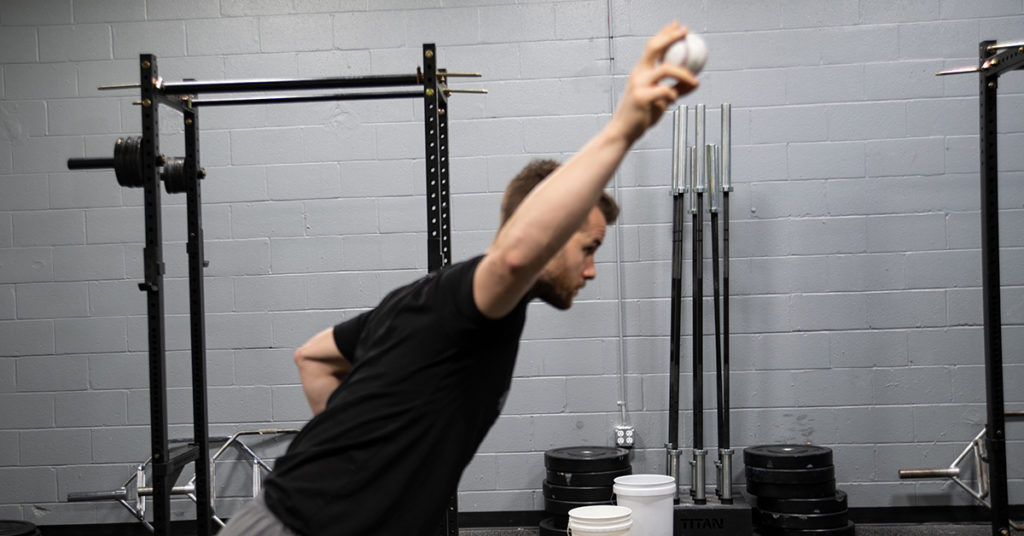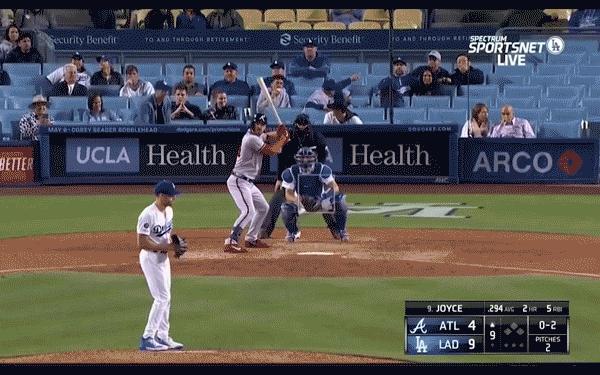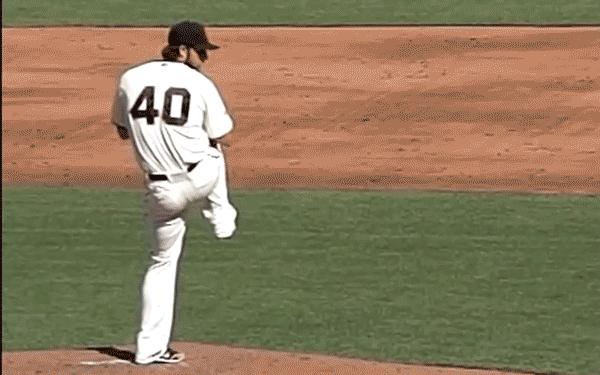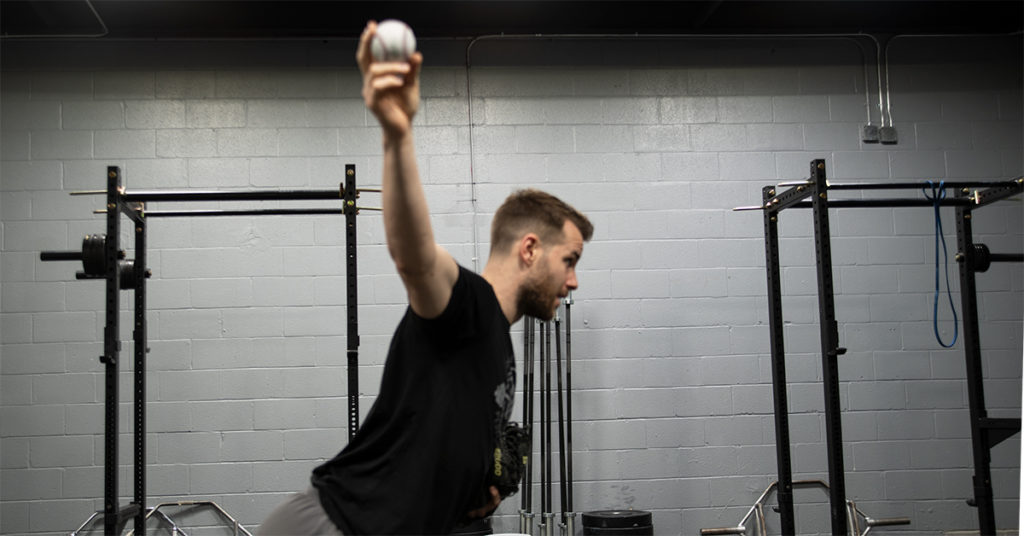There seems to be a fundamental misunderstanding about what a long or short arm action means for pitching velocity. Neither is inherently good or bad, but let’s dig into each a little bit deeper.
First, let’s define short and long arm action. Short arm action is defined by elbow extension of less than 120 degrees at hand separation, and long arm action is anything greater than 120 degrees of elbow extension at hand separation.
What Actually Makes Productive Arm Action?
The goal of a high velocity arm path is to apply force to the baseball over the largest possible arc of motion. All other things being equal this will lead to higher ball velocity.
The first piece to this puzzle is horizontal abduction. This is sometimes referred to as “scap loading.” Basically, this helps to store elastic energy in the pec, which along with the lat, is one of the major contributors to arm acceleration. Greater horizontal abduction at foot strike has been correlated with higher ball velocity (Stodden et al., 2005). The optimal amount of horizontal abduction for each athlete will be slightly different, as there will be differences in individual length-tension relationships with the specific tissues, so more may not always be better in an absolute sense.
The second piece to the puzzle is layback. As I’ve discussed in previous articles, layback is commonly referred to as maximum external rotation (MER) in the literature. However, I prefer layback as it is a more complete term due to the fact that this position is created as a result of thoracic extension, scapular posterior tilt, and glenohumeral external rotation. Greater layback has also been associated with higher ball velocity (Matsuo et al., 2001). Layback places a stretch on the internal rotators, helps store elastic energy, and can lead to more powerful internal rotation after the arm reaches its greatest range of motion.
The final piece is late launch. Late launch refers to where the ball is released in relation to the line of the shoulders. If the ball is released in front of the shoulders it is considered late launch, whereas early launch is anything parallel or behind the shoulders.
Late launch allows for a greater arc of motion as the ball stays in the hand longer as the upper torso rotates, prior to release, while during early launch the ball is released prior to a complete acceleration of the upper torso. Allowing the upper torso to fully accelerate prior to ball release has the additional benefit of improving arm acceleration. If the upper torso and the arm are accelerated at the same time as opposed to in the order of upper torso and then arm, the kinetic chain is not used as efficiently and velocity may be negatively affected.

Potential Issues with Short Arm Action
Short arm action can still allow a pitcher to reach all of the high velocity positions necessary in a successful arm path. There is nothing inherently good or bad about short arm action, however, there are a few potential issues that can present.

The first possible issue is that if a pitcher is too fast to the flipped-up position it can interrupt the smooth flow of energy through the arm path. This tends to happen if the pitcher is making a conscious effort to shorten the arm action, or if the throwing hand is separated from the glove hand primarily through an abduction strategy (driving the elbow up), rather than a retraction-based strategy.
The second issue works hand in hand with the first and is that horizontal abduction, or “scap loading,” can be reduced as the result of shortening an arm action. If a pitcher has a naturally long arm action and attempts to shorten it significantly, it can result in a lack of retraction, as the main concern becomes getting the hand from the glove to a flipped-up position via a much shorter path.
Potential Issues with Long Arm Action
As with a short arm action, there is nothing inherently problematic about a long arm action, but there are potential problems.

The first issue that can present is an elbow lockout shortly after hand separation. If the elbow is fully extended at any point, the stored energy that has been built during the downswing has been lost and must be rebuilt. This can lead to “muscling up” or early tension in muscles in order to try to find that energy again. As we know from chaos theory, a small timing difference in a muscle firing can have a major impact on ball velocity.
The second issue that can present is a “forearm flyout.” This is a term coined by Ron Wolforth and describes a flipped-up position in which the elbow is flexed at an angle greater than about 90-100 degrees. This position leads to less efficient arm acceleration. The elbow tends to extend too early and get too far from the center of mass leading to greater stress being placed on the medial elbow and inefficient energy transfer. This is due to the fact that a more flexed elbow allows inertial forces to lay the arm back and help the tissues to store elastic energy (Roach et al., 2013). A more extended elbow does not allow this to happen as efficiently. Additionally, greater elbow extension at ball release (as a forearm flyout tends to set pitchers up for) is associated with higher elbow valgus torque, which may or may not be problematic depending on a variety of individual factors (Aguinaldo and Chambers, 2009).
Conclusion
Pitching mechanics are like a fingerprint. They’re unique to every athlete and no two athletes should be forced to move in the exact same way. Arm action is one portion of the delivery which tends to be especially unique as a result of habits created by athletes when they are young, playing multiple positions, or what feels and works best based on their anthropometrics. Artificially changing the length of the arm action may cause more harm than good as neither long or short arm action is inherently superior to the other. Athletes should be allowed to be unique provided they stay within certain performance and potentially health related parameters illuminated by research and experience.
Interested in training with us in-person or remotely? Contact us and let’s set up a time to discuss your needs?
References
Stodden DF, Fleisig GS, McLean SP, Andrews JR (2005) Relationship of biomechanical factors to baseball pitching velocity: within pitcher variation. The Journal of Applied Biomechanics.
Matsuo, Tomoyuki & Escamilla, Rafael & Fleisig, Glenn & W. Barrentine, Steven & R. Andrews, James. (2001). Comparison of Kinematic and Temporal Parameters between Different Pitch Velocity Groups. Journal of Applied Biomechanics. 17. 1-13. 10.1123/jab.17.1.1.
Roach N, Madhusudhan V, Rainbow M, Lieberman D (2013) Elastic energy storage in the shoulder and the evolution of high-speed throwing in Homo. Nature.
Aguinaldo A, Chambers H (2009) Correlation of throwing mechanics with elbow valgus load in adult baseball pitchers. The American Journal of Sports Medicine.

